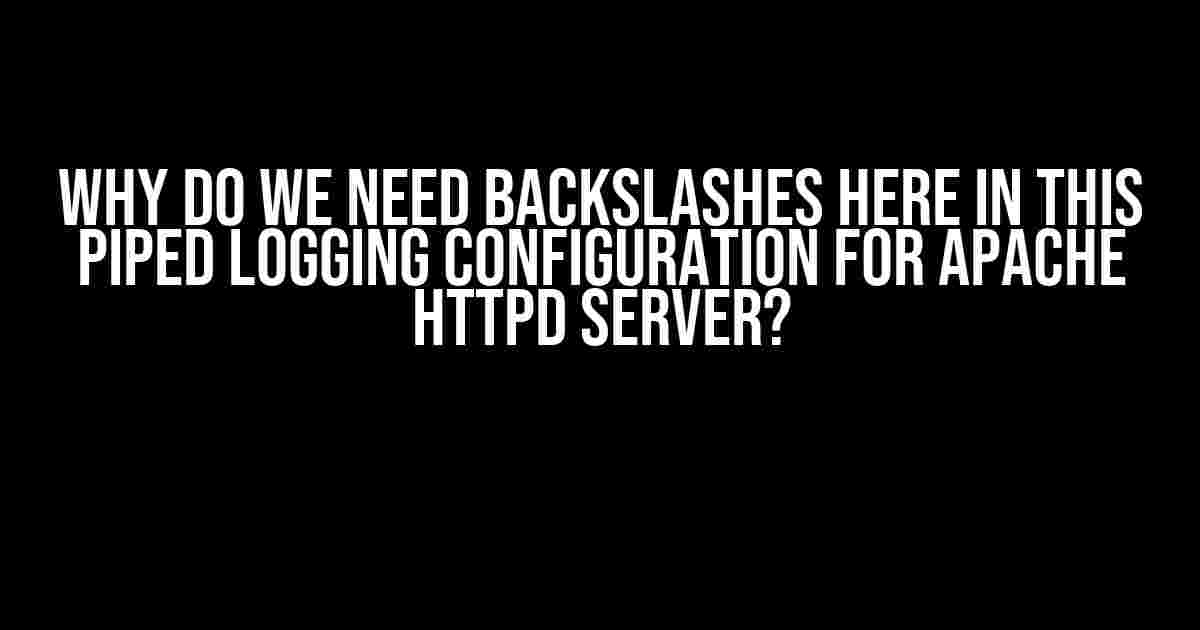When configuring the logging settings for your Apache Httpd Server, you may have come across a peculiar requirement – the use of backslashes in piped logging configurations. You might have wondered, “Why do we need backslashes here?” Well, wonder no more! In this article, we’ll delve into the world of piped logging, explore the role of backslashes, and provide clear instructions on how to configure your Apache Httpd Server logging settings.
What is piped logging?
Piped logging is a mechanism in Apache Httpd Server that allows you to pipe log messages to an external program or script for further processing. This approach provides flexibility and customization options for log analysis, filtering, or forwarding to other systems. Piped logging configurations typically involve specifying the program or script to receive the log messages, along with any necessary arguments or options.
The problem: when backslashes are required
When configuring piped logging, you might encounter a situation where you need to specify a Windows-style path (e.g., `C:\Program Files\log_processor.exe`) as the program or script to receive the log messages. This is where backslashes come into play. Without proper handling, the backslashes in the path can cause issues with the logging configuration.
Why do we need backslashes?
In Windows-style paths, backslashes (`\`) are used to separate directories and file names. However, in Apache Httpd Server’s configuration files, backslashes have a special meaning – they are used to escape special characters. When specifying a Windows-style path in a piped logging configuration, the backslashes need to be escaped to avoid misinterpretation by the Apache Httpd Server.
For example, if you want to specify the path `C:\Program Files\log_processor.exe` as the program to receive log messages, you would need to escape the backslashes like this:
CustomLog "|C:\\Program Files\\log_processor.exe" commonIn this example, the double backslashes (`\\`) are used to escape the backslashes in the path, ensuring that Apache Httpd Server interprets the path correctly.
Configuring piped logging with backslashes
To configure piped logging with backslashes, follow these steps:
-
Identify the program or script that will receive the log messages. Make sure to specify the correct path, including any necessary arguments or options.
-
In your Apache Httpd Server configuration file (e.g., `httpd.conf` or `apache2.conf`), add the following directive:
CustomLog "|<program_path>" commonReplace `
` with the actual path of the program or script, including any necessary backslashes. -
Escape any backslashes in the path by replacing them with double backslashes (`\\`). For example:
CustomLog "|C:\\Program Files\\log_processor.exe" common -
Save the changes to your Apache Httpd Server configuration file.
-
Restart the Apache Httpd Server service to apply the changes.
| Example Paths | Escaped Paths |
|---|---|
| C:\Program Files\log_processor.exe | C:\\Program Files\\log_processor.exe |
| C:\Windows\System32\log_analyzer.exe | C:\\Windows\\System32\\log_analyzer.exe |
Common pitfalls to avoid
When working with piped logging configurations, it’s easy to make mistakes that can lead to issues. Here are some common pitfalls to avoid:
-
Forgetting to escape backslashes: Failing to escape backslashes can cause Apache Httpd Server to misinterpret the path, leading to errors or unexpected behavior.
-
Using forward slashes instead of backslashes: Windows-style paths use backslashes, not forward slashes. Using forward slashes can cause the path to be interpreted incorrectly.
-
Not accounting for spaces in the path: Spaces in the path can cause issues if not properly escaped or quoted.
Conclusion
In conclusion, backslashes play a crucial role in piped logging configurations for Apache Httpd Server, especially when working with Windows-style paths. By understanding the purpose of backslashes and how to properly escape them, you can configure piped logging with confidence. Remember to follow the guidelines outlined in this article to avoid common pitfalls and ensure that your logging configuration works as intended.
Now that you’ve mastered the art of piped logging with backslashes, you’re ready to take your Apache Httpd Server logging to the next level!
Frequently Asked Question
Get ready to unravel the mystery of backslashes in piped logging configurations for Apache Httpd Server!
Why do I need backslashes in my piped logging configuration?
Backslashes (“) are used to escape special characters in shell commands. In the context of piped logging, the backslashes ensure that the pipe (|) character is treated as a literal character rather than a special character that redirects output. Without backslashes, the pipe would be interpreted as a shell redirect, causing unintended behavior.
Are backslashes only necessary for pipe characters?
No, backslashes are necessary for any special characters that have a special meaning in shell commands, such as $, `, and ;. These characters need to be escaped with a backslash to ensure they are treated as literal characters rather than special characters that could alter the logging behavior.
What happens if I forget to use backslashes in my piped logging configuration?
If you forget to use backslashes, the shell may interpret special characters incorrectly, leading to unintended behavior, such as unexpected redirects or errors. This can result in incorrect logging, data loss, or even security vulnerabilities. Always remember to escape special characters with backslashes to ensure proper logging functionality.
Can I use forward slashes (/) instead of backslashes () in my piped logging configuration?
No, forward slashes (/) are not used for escaping special characters in shell commands. Forward slashes are used to specify paths or directories, whereas backslashes () are used to escape special characters. Using forward slashes instead of backslashes can lead to incorrect logging behavior and errors.
Are backslashes required for all logging configurations or just piped logging?
Backslashes are primarily required for piped logging configurations that involve shell commands. However, it’s a good practice to use backslashes to escape special characters in all logging configurations to ensure correct interpretation and prevent errors.

